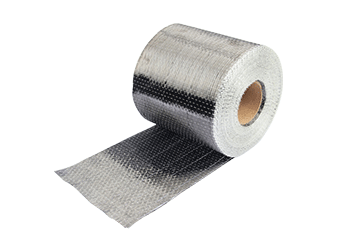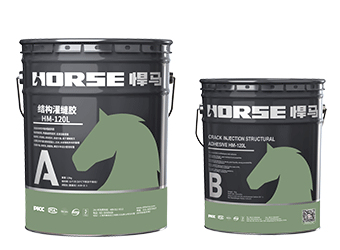Solusi
Horse Construction menawarkan rangkaian lengkap material perkuatan struktur dengan dukungan teknis, dukungan dokumentasi, dukungan produk, dukungan perangkat lunak, dukungan proyek.
Chemical injection and carbon fiber CFRP repairing cracks in concrete dams
Cracks are one of the diseases of dam concrete. Almost all dam concrete projects have different degrees of cracks. It is just that the location, number and size (length, width, depth) of the cracks are different, which brings varying degrees of harm to the safe operation of the dam. Therefore, it is very necessary to repair and strengthen the cracks in the concrete dam. In the past, in order to repair cracks in reinforced concrete dams, other repair and reinforcement measures such as chemical grouting or cement grouting and bonding steel were used.
Now with the application of carbon fiber technology, it becomes very easy, and the structure is closed, which can achieve good waterproof and anti-corrosion effects. Therefore, the comprehensive technology of chemical grouting and carbon fiber cloth is a very suitable method to repair and strengthen the cracks in the concrete dam. Because chemical grouting treatment of cracks can restore the integrity of the dam. The use of carbon fiber cloth(CFRP) for repair and reinforcement can reduce the stress at the joint end and prevent the further development of cracks.
1 Chemical grouting method to treat cracks
Firstly, the modified epoxy grouting material is used to repair the cracks. It repairs and seals the cracks to ensure that the steel bars inside the cracks are not corroded.
Crack grouting and its construction technology
①Modified filling materials. Modified grouting material is an interwoven network polymer formed by interpenetrating epoxy resin and other polymers to form chains. It not only has the advantages of high epoxy resin strength, small shrinkage, good adhesion performance and good chemical stability. Moreover, it overcomes the shortcomings of high viscosity and poor pourability, and is suitable for grouting requirements for fine cracks, especially deep cracks, and the grout does not contain any solvent.
② Construction technology of crack grouting.
Clear seams. Use wire brushes and other tools to remove dust, scum, loose layer and dirt on the crack surface. Then use a brush dipped in alcohol, toluene and other solutions to clean the surface of the concrete and keep it clean and dry.
The spacing between the buried grouting box and the cloth box depends on the width of the crack. Generally 800~1000mm, the position of the grouting box should be located at the crack end, the crack intersection and the wide crack. Grout boxes should be placed on both sides of the component penetrating the crack.
Seal seam. Use epoxy resin cement to seal, prevent small holes and air bubbles when applying cement. Try to make the scraping surface as smooth as possible to ensure reliable sealing of cracks.
Slurry preparation. According to the solidification time of the slurry and the slurry feeding speed, determine the number of slurry equipment at one time.
Grouting. On the basis of fully preparing the crack surface treatment process, the cracks can be grouted from the bottom to the top. Pay attention to the change of pressure gauge during grouting to keep the pressure at 0.2~0.4 MPa. If the pressure drops slightly, it means that the grout is being fed; if the pressure tends to exceed 0.4 MPa, it means it has been filled and the grouting nozzle needs to be replaced. For thin structures that penetrate the cracks (the thickness of the structural grouting is less than 1 in), if the grout leaks from the upper nozzle during grouting, it means it has been filled and the grouting nozzle can be replaced. After each mouth is filled with grout, seal the rubber tube immediately to prevent the grout from leaking out.
2 Carbon fiber reinforcement construction process and steps
The characteristics of carbon fiber and carbon fiber reinforcement
Carbon fiber has a wide range of applications, not only has good plasticity, but also can be well applied to curved and irregularly shaped structures. Light weight, low density, basically no increase in structural weight. The construction is convenient, the work efficiency is high, and no large construction machinery is required. It has strong corrosion resistance and durability. There is no need for bolts and rivets during the reinforcement construction, which has little disturbance to the existing structure, will not affect the integrity of the existing structure, and has strong waterproof performance. The comprehensive cost is relatively low. The axial tensile strength is ten times greater than that of ordinary carbon steel. In repairing concrete structures, it can make full use of its high strength and high elastic modulus characteristics to improve the strength of the concrete structure and the bearing capacity and ductility of components, improve its stress performance, and achieve the purpose of efficient reinforcement and repair. Therefore, carbon fiber materials have been widely used in concrete structure reinforcement projects.
Carbon fiber material is flexible, even if the surface of the reinforced structure is not very flat. It can also achieve an effective paste rate of 99%. Or even if bubbles are found on the surface after pasting, it is easy to repair. Just use a syringe to inject the resin into the air bubbles and remove the air, which can ensure the quality of the reinforcement construction. In the past, in order to repair and reinforce the cracks in concrete dams, the sticking steel method, chemical grouting method or cement grouting method and other reinforcement measures were used. Now with the application of carbon fiber technology, it becomes very easy, and the structure is closed to achieve good waterproof and anti-corrosion effects. Therefore, the use of carbon fiber to repair and strengthen the cracks in the concrete dam is a very suitable method.
Conclusion
In summary, the comprehensive technology of chemical grouting and carbon fiber cloth repairing and strengthening concrete dam cracks has the following obvious advantages. Chemical grouting treatment of cracks can restore the integrity of cracked concrete. Carbon fiber cloth has high strength, light weight, good reinforcement effect, and basically does not increase the weight of the structure and the cross-sectional size. Carbon fiber cloth has super waterproof and anti-corrosion effects, and can greatly improve the corrosion resistance and waterproof performance of concrete dams after reinforcement. In addition, it has the advantages of convenient construction, easy operation, short construction period, and high efficiency.
Anda dapat menemukan segala yang Anda butuhkan di sini. Percayalah dan cobalah produk - produk ini, Anda akan menemukan perbedaan yang besar setelah itu.

Lembaran serat karbon Horse Construction digunakan untuk perkuatan struktural, perbaikan, dan perbaikan substrat beton, pasangan bata, baja, dan kayu pada bangunan, jembatan, jalan raya, rel kereta api, terowongan, dermaga, dan bandara sipil.

Pelat polimer bertulang serat karbon (CFRP) Horse adalah pelat komposit yang diawetkan terlebih dahulu, yang diikatkan ke struktur sebagai perkuatan eksternal dengan epoksi HM-120CP.

Perekat injeksi retak beton Horse HM-120L adalah epoxy yang digunakan untuk memperbaiki retakan beton dengan cara menyuntikkannya. Epoxy ini memiliki daya tembus yang tinggi. Penyuntikan retakan pada beton struktural dengan tekanan rendah.